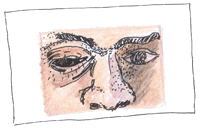|
Weakness is the defining symptom of myasthenia gravis. Patients may not recognize it as such and complain to their doctor of double vision, difficulty swallowing, slurring of speech, or even a change in gait. Five areas of motor function are commonly affected and involve the muscles that control the following:
 |
the eye |
 |
the face, nose and throat |
 |
respiration |
 |
the torso (pectoral and pelvic muscles), and |
 |
the arms and legs. |
The symptoms may fluctuate from hour to hour, from day to day, or over longer periods. They are provoked or worsened by exertion, exposure to extremes of temperature, viral or other infections, menses and excitement.
The symptoms experienced are commonly these:
 |
Eye muscle involvement often results in drooping of the upper eyelid and double vision. It usually affects both eyes and is asymmetrical. |
 |
Weakness of other muscles innervated by cranial nerves results in loss of facial expression, everted (pouting) lips, a smile that resembles a snarl, jaw drop, nasal regurgitation of liquids, choking on foods and secretions, and a slurred, nasal speech with a reduced volume. |
 |
Depending on the severity of the disease, difficulty breathing can appear on moderate or mild exertion or be present even at rest. |
 |
Abnormal tiredness of the limb muscles causes difficulty in combing the hair, lifting objects repeatedly, climbing stairs, walking and running. |
 |
| Drooping of the eyelids is an early symptom of myasthenia gravis. |
Initially, the symptoms affect only the eyes in 40 per cent of patients; are generalized in 40 per cent; involve only the extremities in 10 per cent; and affect only the nose, mouth or throat, or these muscles and the eye muscles in another 10 per cent. Subsequently, the weakness can spread from the eye to the facial, salivary, swallowing and respiratory muscles and then to the torso and limb muscles, but the sequence may vary. Arm and leg muscles are affected more than hands and feet. In the most advanced cases the weakness is general throughout the body.
By the end of the first year, the eye muscles are affected in nearly all patients. The symptoms remain ocular (involving the eye) in only 16 per cent. In nearly 90 per cent of those in whom the disease becomes generalized, this occurs within the first year after the onset. Progression is most rapid within the first three years, and more than half of the deaths caused by myasthenia gravis occur in that period.
Spontaneous remissions lasting from weeks to years can occur. Long remissions are uncommon, and most remissions occur during the first three years. |
| |
|
|
TCM practitioners will examine a sufferer and categorize symptoms under special syndrome groups known as "disharmony patterns." Certain disharmony patterns are present at different stages of a disorder. In myasthenia gravis, these can be classified into the following types:
Qi-deficiency in the spleen and stomach
Individuals present with drooping eyelids, weakness of the limbs, and difficulty in holding the head up and chewing food. Symptoms are worse towards the end of the day. Others symptoms include poor appetite, diarrhea, a reluctance to speak and shortness of breath.
Yang-deficiency in the spleen and kidneys
This often presents with drooping eyelids, limitation in muscular control of the eye, and limb weakness. Other accompanying symptoms are soreness in the loin region, spontaneous sweating, aversion to cold temperatures, cold limbs, a pale complexion, difficulty in swallowing, poor appetite and diarrhea, and the excretion of large volumes of dilute urine.
Yin-deficiency in the liver and kidneys
The main symptoms include drooping eyelids, difficulty in swallowing and chewing food, and limb weakness. Symptoms worsen towards the end of the day. Other accompanying symptoms are soreness and weakness in the lumbar (lower back) region and knees, dizziness, ringing in the ears, insomnia and nightmares. A feeling of dryness in both eyes and a hot sensation in the chest, palms of the hands and soles of the feet can develop.
Deficiency in both qi and blood
Individuals present with fatigue and weakness, palpitation, shortness of breath, a reluctance to speak, pale complexion, drooping eyelids, difficulty in swallowing and chewing food, muscle wasting and fatigue, and spontaneous sweating.
.
|
| |
|